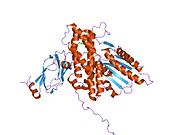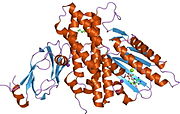PDK3
Ensembl | |||||||||
|---|---|---|---|---|---|---|---|---|---|
| UniProt | |||||||||
| RefSeq (mRNA) | |||||||||
| RefSeq (protein) | |||||||||
| Location (UCSC) | Chr X: 24.47 – 24.55 Mb | Chr X: 92.81 – 92.88 Mb | |||||||
| PubMed search | [3] | [4] | |||||||
| View/Edit Human | View/Edit Mouse |
Pyruvate dehydrogenase lipoamide kinase isozyme 3, mitochondrial is an enzyme that in humans is encoded by the PDK3 gene.[5]
Structure
The structure of the PDK3/L2 complex has been elucidated, and there are several key features. When the L2 domain binds to PDK3, it induces a “cross-tail” conformation in PDK3, thereby stimulating activity. There are three crucial residues, Leu-140, Glu-170, and Glu-179, in the
Function
The Pyruvate Dehydrogenase (PDH) complex must be tightly regulated due to its central role in general metabolism. Within the complex, there are three serine residues on the E1 component that are sites for phosphorylation; this phosphorylation inactivates the complex. In humans, there have been four
Regulation
As the primary regulators of a crucial step in the central metabolic pathway, the pyruvate dehydrogenase family is tightly regulated itself by a myriad of factors. PDK3, in conjunction with PDK2 and PDK4, are primary targets of peroxisome proliferator-activated receptor delta/beta (PPAR beta/delta), with PDK3 having five elements that respond to these receptors.[12]
References
- ^ a b c GRCh38: Ensembl release 89: ENSG00000067992 – Ensembl, May 2017
- ^ a b c GRCm38: Ensembl release 89: ENSMUSG00000035232 – Ensembl, May 2017
- ^ "Human PubMed Reference:". National Center for Biotechnology Information, U.S. National Library of Medicine.
- ^ "Mouse PubMed Reference:". National Center for Biotechnology Information, U.S. National Library of Medicine.
- PMID 7499431.
- ^ a b "Entrez Gene: PDK3 pyruvate dehydrogenase kinase, isozyme 3".
- PMID 16849321.
- PMID 15861126.
- PMID 17532006.
- PMID 11485553.
- PMID 12476789.
- PMID 17669420.
Further reading
- Sugden MC, Holness MJ (Jul 2002). "Therapeutic potential of the mammalian pyruvate dehydrogenase kinases in the prevention of hyperglycaemia". Current Drug Targets. Immune, Endocrine and Metabolic Disorders. 2 (2): 151–65. PMID 12476789.
- Sugden MC, Holness MJ (May 2003). "Recent advances in mechanisms regulating glucose oxidation at the level of the pyruvate dehydrogenase complex by PDKs" (PDF). American Journal of Physiology. Endocrinology and Metabolism. 284 (5): E855–62. S2CID 12494500. Archived from the original(PDF) on 2019-03-08.
- Baker JC, Yan X, Peng T, Kasten S, Roche TE (May 2000). "Marked differences between two isoforms of human pyruvate dehydrogenase kinase". The Journal of Biological Chemistry. 275 (21): 15773–81. PMID 10748134.
- Kolobova E, Tuganova A, Boulatnikov I, Popov KM (Aug 2001). "Regulation of pyruvate dehydrogenase activity through phosphorylation at multiple sites". The Biochemical Journal. 358 (Pt 1): 69–77. PMID 11485553.
- Korotchkina LG, Patel MS (Oct 2001). "Site specificity of four pyruvate dehydrogenase kinase isoenzymes toward the three phosphorylation sites of human pyruvate dehydrogenase". The Journal of Biological Chemistry. 276 (40): 37223–9. PMID 11486000.
- Tuganova A, Boulatnikov I, Popov KM (Aug 2002). "Interaction between the individual isoenzymes of pyruvate dehydrogenase kinase and the inner lipoyl-bearing domain of transacetylase component of pyruvate dehydrogenase complex". The Biochemical Journal. 366 (Pt 1): 129–36. PMID 11978179.
- Spriet LL, Tunstall RJ, Watt MJ, Mehan KA, Hargreaves M, Cameron-Smith D (Jun 2004). "Pyruvate dehydrogenase activation and kinase expression in human skeletal muscle during fasting" (PDF). Journal of Applied Physiology. 96 (6): 2082–2087. S2CID 13601849. Archived from the original(PDF) on 2019-02-25.
- Blackshaw S, Harpavat S, Trimarchi J, Cai L, Huang H, Kuo WP, Weber G, Lee K, Fraioli RE, Cho SH, Yung R, Asch E, Ohno-Machado L, Wong WH, Cepko CL (Sep 2004). "Genomic analysis of mouse retinal development". PLOS Biology. 2 (9): E247. PMID 15226823.
- Kato M, Chuang JL, Tso SC, Wynn RM, Chuang DT (May 2005). "Crystal structure of pyruvate dehydrogenase kinase 3 bound to lipoyl domain 2 of human pyruvate dehydrogenase complex". The EMBO Journal. 24 (10): 1763–74. PMID 15861126.
- Rual JF, Venkatesan K, Hao T, Hirozane-Kishikawa T, Dricot A, Li N, Berriz GF, Gibbons FD, Dreze M, Ayivi-Guedehoussou N, Klitgord N, Simon C, Boxem M, Milstein S, Rosenberg J, Goldberg DS, Zhang LV, Wong SL, Franklin G, Li S, Albala JS, Lim J, Fraughton C, Llamosas E, Cevik S, Bex C, Lamesch P, Sikorski RS, Vandenhaute J, Zoghbi HY, Smolyar A, Bosak S, Sequerra R, Doucette-Stamm L, Cusick ME, Hill DE, Roth FP, Vidal M (Oct 2005). "Towards a proteome-scale map of the human protein-protein interaction network". Nature. 437 (7062): 1173–8. S2CID 4427026.
- Tso SC, Kato M, Chuang JL, Chuang DT (Sep 2006). "Structural determinants for cross-talk between pyruvate dehydrogenase kinase 3 and lipoyl domain 2 of the human pyruvate dehydrogenase complex". The Journal of Biological Chemistry. 281 (37): 27197–204. PMID 16849321.
- Devedjiev Y, Steussy CN, Vassylyev DG (Jul 2007). "Crystal structure of an asymmetric complex of pyruvate dehydrogenase kinase 3 with lipoyl domain 2 and its biological implications". Journal of Molecular Biology. 370 (3): 407–16. PMID 17532006.
- Degenhardt T, Saramäki A, Malinen M, Rieck M, Väisänen S, Huotari A, Herzig KH, Müller R, Carlberg C (Sep 2007). "Three members of the human pyruvate dehydrogenase kinase gene family are direct targets of the peroxisome proliferator-activated receptor beta/delta". Journal of Molecular Biology. 372 (2): 341–55. PMID 17669420.
- Kato M, Li J, Chuang JL, Chuang DT (Aug 2007). "Distinct structural mechanisms for inhibition of pyruvate dehydrogenase kinase isoforms by AZD7545, dichloroacetate, and radicicol". Structure. 15 (8): 992–1004. PMID 17683942.



